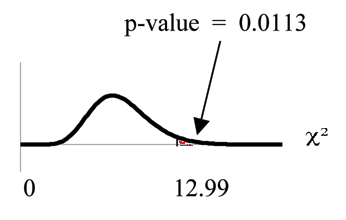| << Chapter < Page | Chapter >> Page > |
In a volunteer group, adults 21 and older volunteer from one to nine hours each week to spend time with a disabled seniorcitizen. The program recruits among community college students, four-year college students, and nonstudents. The following table is a sample of the adult volunteers and the number of hours they volunteer per week.
| Type of Volunteer | 1-3 Hours | 4-6 Hours | 7-9 Hours | Row Total |
|---|---|---|---|---|
| Community College Students | 111 | 96 | 48 | 255 |
| Four-Year College Students | 96 | 133 | 61 | 290 |
| Nonstudents | 91 | 150 | 53 | 294 |
| Column Total | 298 | 379 | 162 | 839 |
Are the number of hours volunteered independent of the type of volunteer?
The observed table and the question at the end of the problem, "Are the number of hours volunteered independent of the type of volunteer?" tell you this is a test ofindependence. The two factors are number of hours volunteered and type of volunteer . This test is always right-tailed.
: The number of hours volunteered is independent of the type of volunteer.
: The number of hours volunteered is dependent on the type of volunteer.
| Type of volunteer | 1-3 Hours | 4-6 Hours | 7-9 Hours | Row Total |
|---|---|---|---|---|
| Community College Students | 255 | |||
| Four-Year College Students | 290 | |||
| Nonstudents | 294 | |||
| Column Total | 298 | 379 | 162 | 839 |
The expected table is:
| Type of Volunteer | 1-3 Hours | 4-6 Hours | 7-9 Hours |
|---|---|---|---|
| Community College Students | 90.57 | 115.19 | 49.24 |
| Four-Year College Students | 103.00 | 131.00 | 56.00 |
| Nonstudents | 104.42 | 132.81 | 56.77 |
For example, the calculation for the expected frequency for the top left cell is
Calculate the test statistic:
Distribution for the test:
Graph:

Probability statement:
Compare and the : Since no is given, assume . . .
Make a decision: Since , reject . This means that the factors are not independent. Because we reject the null hypothesis, we should look at the percentages. We are interested in whether there is a difference in the type of volunteers hours, so we are interested in the row percentages.
| Type of volunteer | > 1-3 Hours | 4-6 Hours | 7-9 Hours | Row Total |
|---|---|---|---|---|
| Community College Students | 111/255=43.53% | 96/255=37.65% | 48/255=18.82% | 255 |
| Four-Year College Students | 96/290=33.10% | 133/290=45.86% | 61/290=21.03% | 290 |
| Nonstudents | 91/294=30.95% | 150/294=51.02% | 53/294=18.02% | 294 |
| Column Total | 298 | 379 | 162 | 839 |
It appears that the community college students mainly volunteer for 1-3 hours on average (43.53% of them), while more 4-year college and non-students volunteer for 4-6 (45.86% and 51.02% respectively) hours on average.
Conclusion: At a 5% level of significance, from the data, there is sufficient evidence to conclude that the number of hours volunteered and the type of volunteer aredependent on one another.
For the above example, if there had been another type of volunteer, teenagers, what would the degrees of freedom be?
De Anza College is interested in the relationship between anxiety level and the need to succeed in school. A random sample of 400 students took a test that measuredanxiety level and need to succeed in school. The table shows the results. De Anza College wants to know if anxiety level and need to succeed in school are independentevents.
| Need to Succeed in School | High
Anxiety |
Med-high
Anxiety |
Medium
Anxiety |
Med-low
Anxiety |
Low
Anxiety |
Row Total |
|---|---|---|---|---|---|---|
| High Need | 35 | 42 | 53 | 15 | 10 | 155 |
| Medium Need | 18 | 48 | 63 | 33 | 31 | 193 |
| Low Need | 4 | 5 | 11 | 15 | 17 | 52 |
| Column Total | 57 | 95 | 127 | 63 | 58 | 400 |
How many high anxiety level students are expected to have a high need to succeed in school?
The column total for a high anxiety level is 57. The row total for high need to succeed in school is 155. The sample size or total surveyed is 400.
The expected number of students who have a high anxiety level and a high need to succeed in school is about 22.
If the two variables are independent, how many students do you expect to have a low need to succeed in school and a med-low level of anxiety?
The column total for a med-low anxiety level is 63. The row total for a low need to succeed in school is 52. The sample size or total surveyed is 400.

Notification Switch
Would you like to follow the 'Collaborative statistics using spreadsheets' conversation and receive update notifications?